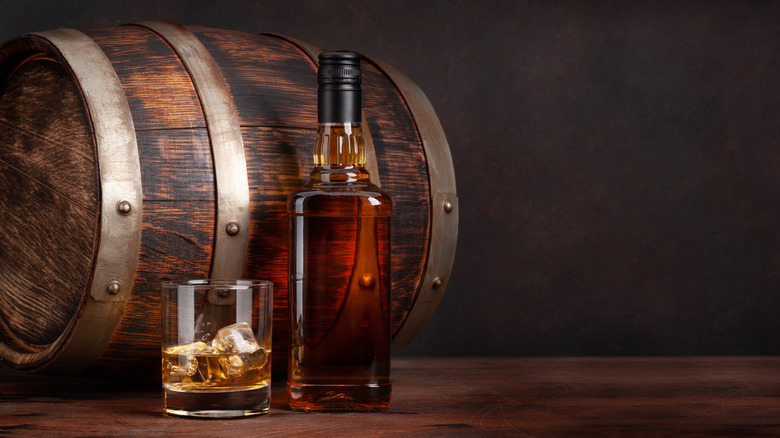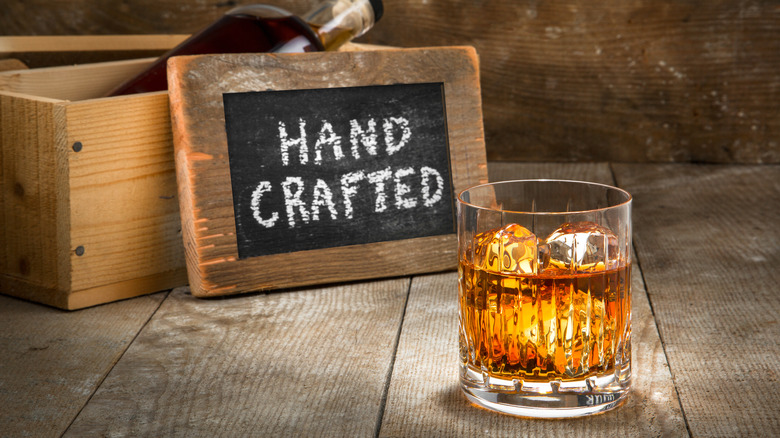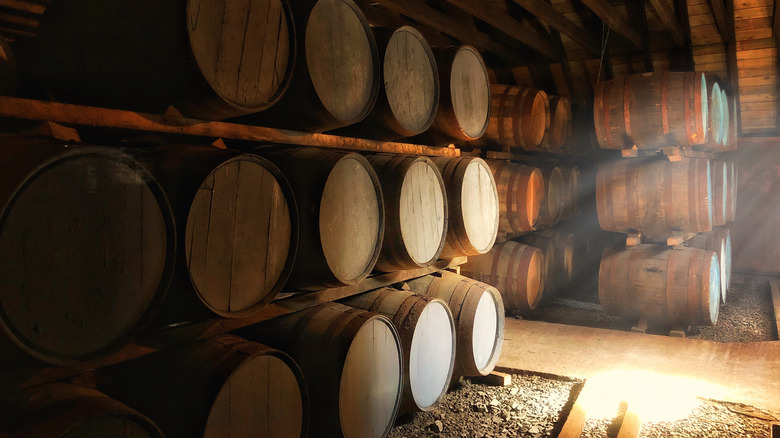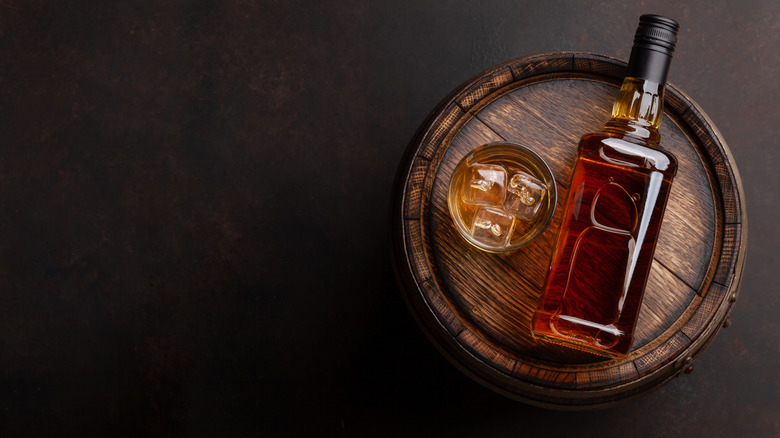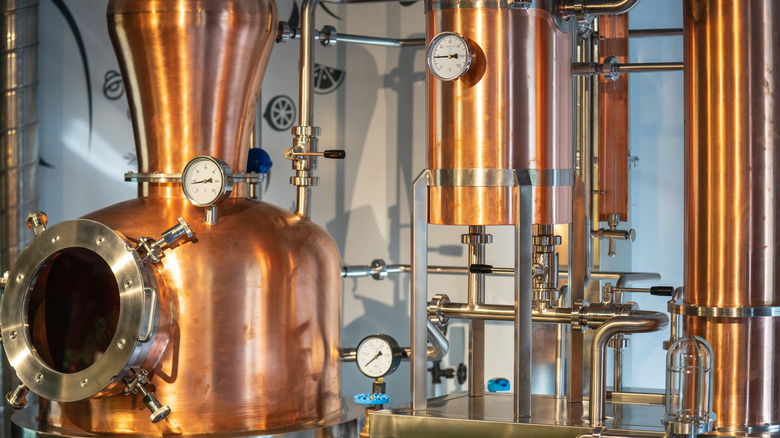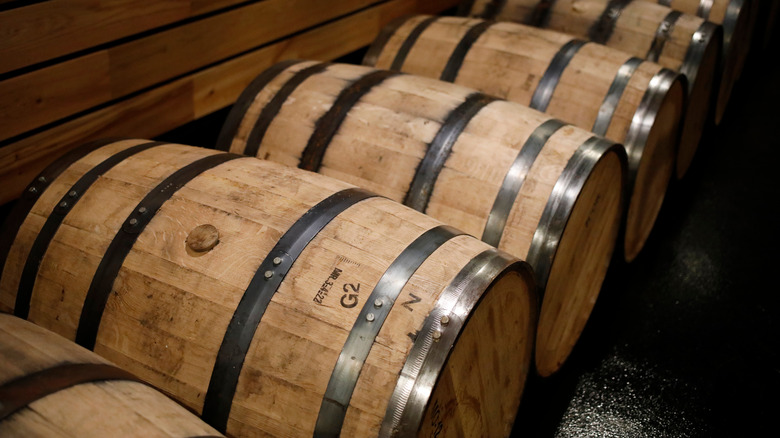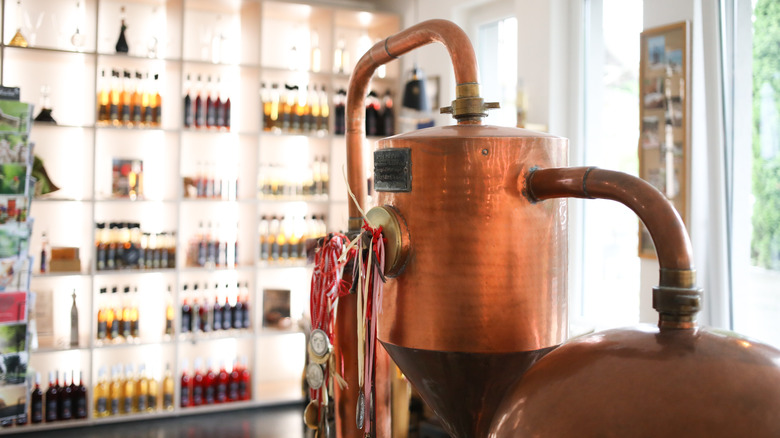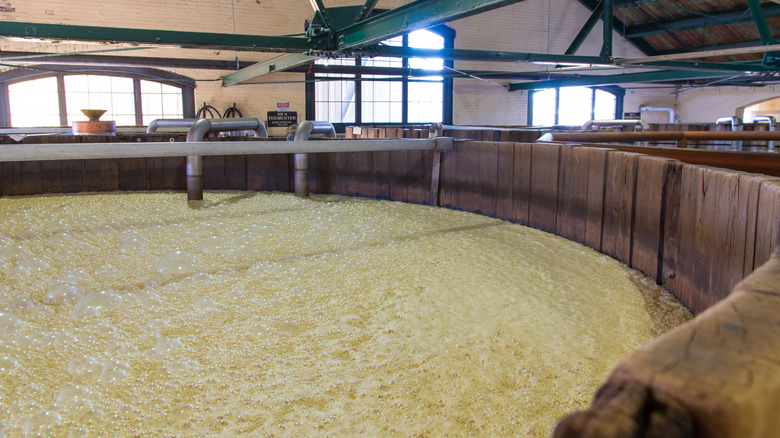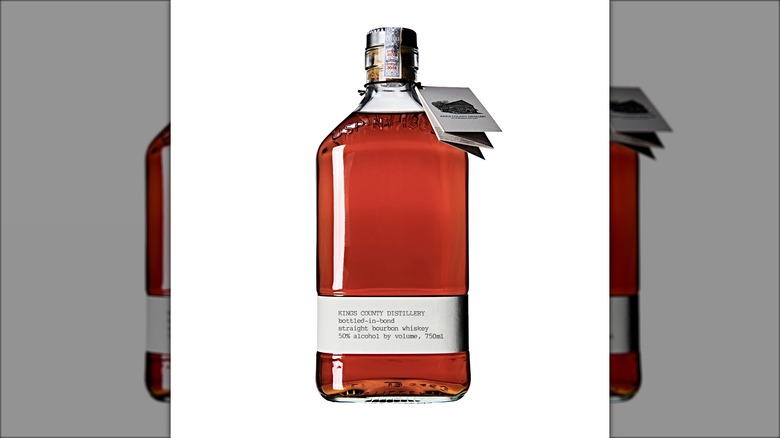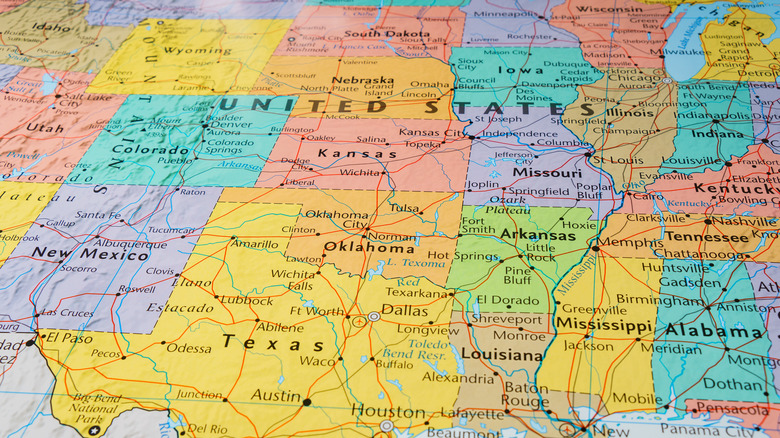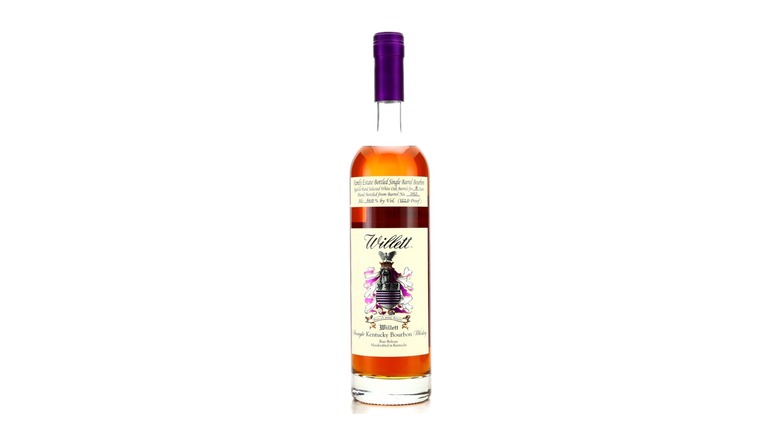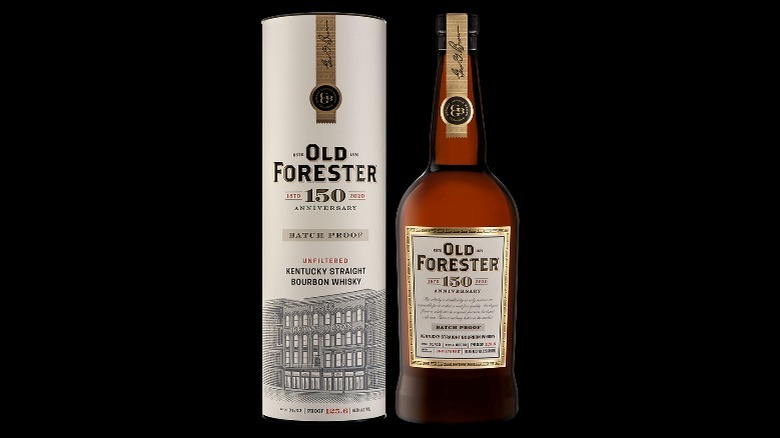13 Ways To Catch Lies On A Bourbon Whiskey Label
Things can get tricky in the world of bourbon, even when you're just dealing with that seemingly simple label on the bottle. There are two main types of lies you can catch on a bourbon whiskey label. The first is a lie of omission. Most often, that takes the form of wording that leads you to believe that a company with a storied past distills its own bourbon when it's actually outsourcing its product. In other cases, bourbons may have been counterfeited for a hefty profit.
Thankfully, a careful reading of what the label isn't telling you can make some of these tricks clear. However, other lies involve more sleuthing. If you're sufficiently motivated to uncover the truth, you may end up asking a city historical society to verify the company's backstory or look online for what others have uncovered about the company.
This isn't just a problem relegated to well drinks. Some of the best bourbons have labeling issues. Moreover, if you like the taste of a bourbon, it may not matter who did the actual distilling — unless you've paid thousands of dollars for the bottle and ended up with a counterfeit. However, most consumers would rather know where their bourbon really came from instead of being fed a bogus line about a recipe that's been in the family for generations. If you're ready to learn how to spot bourbon marketing ploys and fakes, read on.
Words like small-batch, hand-crafted, and craft have no legal definition
When you walk into a local shop or liquor store and see evocative words like "small-batch," "craft," or "hand-crafted," it piques your interest. You like to think that Joe and Frank are over at the (fictional) Best Bourbon Distillery lovingly making and labeling every one of their bourbons personally. Unfortunately, the truth is that these words have no legal definition. There may have never been a Frank in the first place, much less one who lovingly cradled that very bottle.
Legally speaking, the definitions of these words are left entirely up to your imagination. Some phrases are meant for marketing purposes only. They may paint a quaint picture in your mind of the kind of bourbon company to which you can relate. Well-known companies like Jim Beam and Maker's Mark have even had lawsuits filed against them for using legally murky statements like "handcrafted" and "handmade" (via Eater).
Instead, keep an eye out for other terms. The American Distilling Institute has a Certified Craft Distilled Spirit designation that you should look for. To earn this designation, certified craft distilleries must be independently-owned and work on a small scale (that is, they produce fewer than 100,000 gallons per year. The spirit in question must be fermented, distilled, and bottled by the distillery listed on the label. Finally, a qualified distillery must also have a hands-on production process (via American Distilling Institute).
Bourbons labels can get tricky with wording
The phrases "made by," "produced by," and "bottled by" typically mean that a company bottled and labeled a bourbon — but didn't distill it. Unless the label explicitly says it was "distilled by" the company in question, then it's all but certain that the bourbon came from somewhere else (via NBC News).
"Distilled by" is meant to indicate who distilled the bourbon. Anyone else is legally bound to use variations of the phrases "bottled by," "packed by," or "filled by" (via Legal Information Institute). Many bourbon brands you might recognize, such as Bulleit and Templeton, buy pre-distilled bourbon from mass bourbon producers like Midwest Grain Products (MGP). Those brands then sell the product as their own (via USA Today).
Meeting consumer demand can be especially tricky for small distilleries. While a smaller company might make some of its bourbons, it often ends up sourcing production out to a larger company, often because of the time and space it takes to properly age whiskey. It can be financially prohibitive for a small company to distill a product and then store it and wait years to sell it. To make things even more complicated, a distillery may mix it up. Some of the whiskey a small distillery has on hand in its storefront may be genuinely made on-site, but the larger batches of whiskey that it distributes may be produced off-site by a third company (via NBC News).
Don't assume that a company is actually a distillery
Did you know that it's entirely possible to call your company a "distillery" without being an actual distillery? Yes, we were shocked to learn this, too. But it turns out that buying bourbon from a company that calls itself a distillery is no guarantee that there's a working still anywhere on the premises.
Take the example of Goodnight Distillery. Once upon a time, when you bought a bottle of bourbon from this distillery, you'd assume that you were buying from a company that distilled its own bourbon. However, a quick look at the label should have alerted you otherwise. It said that it was "bottled by Goodnight Distillery, Parlier, California." The "bottled by" statement indicated that Goodnight was simply the bottler of a pre-made "Kentucky straight" that had been crafted elsewhere, as LEO Weekly reports. The Goodnight Distillery has since changed its name to Charles Goodnight in an effort to come clean.
The moral of our fable? Don't decline to read the label just because the bourbon comes from a so-called "distillery." Anybody can call themselves anything they want, but it doesn't make it a reality.
Don't assume that a distillery makes all the bourbon it sells
If you visit a bourbon distillery, it may offer tours of its distillery operations, which can give you the illusion that it is making everything that is sold on-site. However, this isn't always true. Have you ever noticed that you can't get the same types of bourbon from a company at a liquor store as you can find in its storefront? That's because many companies just don't have a large enough production setup to meet demand. While the bourbon you drank may have come from the stills you saw at the local distillery, it may be also using a larger company to outsource the bourbons it's placing on liquor store shelves. For example, Widow Jane makes all the bourbons it sells in its local storefront. Yet, any of its whiskey that you get at a bar or liquor store is outsourced (via NBC News).
Perhaps it's not all the distillery's fault, however. NBC says that it's a simple matter of supply and demand. With the popularity of bourbon increasing in the last decade, many small distilleries can't produce as much bourbon whiskey as fans demand.
If it isn't labeled a single barrel bourbon, there's no age guarantee
Straight bourbon must be aged two years, so you can always assume that genuine bourbon is at least two years old (via CNBC). In the case of barrels that have been mixed, it's legally required that distilleries list the age according to the youngest bourbon in the blend. For instance, if a company mixes a 6-year-old bourbon with a 4-year-old variety, the company is legally obligated to list the result as a 4-year-old bourbon.
The only way you can know for sure that every drop of bourbon in the bottle is a given age is if the label refers to a "single barrel" bourbon. Yet, the only bourbons that must have an age statement on the label are those that were aged four years or less. So, you may not even see an age statement on a bottle aged for longer (via Art of Manliness).
Often, newer companies omit age statements altogether if their bourbons are older than four years. Such a company simply can't have produced a prestigious 10-year-old bourbon, so it doesn't bother. When a company can age bourbon 10 years or more, you're going to see it boldly proclaimed on its label. With the current high demand for whiskeys of all kinds, you're likely to see fewer longer-aged bourbons on the shelves since the companies can't afford to let them sit around and age for very long (via LEO Weekly).
The company's history may be made up
Unfortunately, the company histories of some of the younger bourbon companies are nothing short of complete malarky. Some of these origin tales have been created out of whole cloth just to market bourbon. With the number of bourbon distilleries growing from around 100 to around 1,300 within the last 10 years, you should take some of the companies' supposedly storied histories with a grain of salt (via NBC News). In other words, if the company's marketing copy says that it got its recipe from someone's grandpa, just stop reading. Everyone's grandpa can't have been sitting on a family recipe for bourbon all this time.
Sometimes, you have to dig even deeper to uncover bourbon label untruths. For example, Widow Jane says that the limestone-rich water it uses for its bourbon whiskey comes from a mine in Rosendale, New York, naturally called the Widow Jane mine. However, NBC reported that a short chat with the historical society in Rosendale revealed that this information was a total falsehood. Not every cute story you read on the back of a bourbon bottle is true, so sleuth around if the story matters concerning how you view the company.
If a new distillery is selling bourbon, check again
Legally, a spirit has to have been aged in a new, charred oak barrel for a minimum of two years to be called bourbon (via CNBC). This means that a brand new distillery could sell white whiskey from its own production company, but it couldn't sell you straight bourbon — unless it came from another, more-established producer. White whiskey doesn't even have to have to spend any time in a barrel before it goes into a bottle, as per VinePair.
If you're visiting a brand new bourbon distillery and it's selling you something with its own label called "bourbon," you'd be right to question it. If you notice that a company was founded five years ago and it's selling 15-year-old bourbon, that is a clear indication that the company is outsourcing at least some of its bourbon production (if not all of it).
When the company is old enough to fly on its own, customers may still have unrealistic demands, having come to expect the distillery's bourbon to have a specific flavor. Yet that distillery may not be able to reproduce that taste on-site, meaning that the dependency on outsourcing continues (via USA Today).
Take a careful look at the ingredients
By law, bourbon has to contain at least 51% corn. Other grains provide different brands of bourbon whiskeys with their distinctive flavors. Some of the mass-production distilleries, like MGP, offer distinctive recipe options to customers, like formulas with 45% wheat, 49% barley malt, 21% rye, 36% rye, or even 99% corn (via MGP). If you see these specific percentages on a bourbon label, there's a chance that the bourbon company got its bourbon from MGP (via USA Today).
MGP does offer the option to create propriety custom bourbons for different labels (via MGP). However, any new company wouldn't have access to any of those barrels until the bourbon had aged. Instead, new companies are forced to choose from pre-aged bourbon barrels, which will have very specific and non-customizable percentages of grains. If you're curious about where a new bourbon company is getting its bourbon, look into the grain percentages from a few mass-production bourbon distilleries until you find a match.
Look for a bottled-in-bond designation
Bourbon producers have been engaging in sketchy practices for quite a while. Back in 1897, it had become common practice for some distillers to dilute their product so that they could sell more, reports LEO Weekly. Some even attempted to add illegal flavorings to their spirits, like tea and prune juice. One scrupulous distiller, Edmund Taylor, decided he wanted to protect his brand's reputation and worked to get the Bottled-in-Bond Act passed.
Nowadays, any bourbon that earns the Bottled-in-Bond (B-I-B) designation must have been aged at least four years and can come from only one distillery and distiller in a single year. Furthermore, the bourbon must be bottled at exactly 100 proof and aged in barrels in a federally-bonded warehouse. If you're looking for a B-I-B bourbon, you'll always find the name of the distillery name on the label, along with a designation that it's a bonded bourbon (via LEO Weekly).
LEO Weekly notes that not all bourbons have to be bonded to be legitimate. In fact, only about 20 bourbons meet the stringent standards set out in the 1897 B-I-B Act. However, if you're trying to decide which type of bourbon to get and see a B-I-B designation on a label, you know exactly what you're getting. There's no mixing of bourbons from different barrels and years, there's no hanky panky involved in who distilled the whiskey, the alcohol content is great for mixed drinks, and you know you're getting the real deal.
Notice if the state of distillation is missing
Many things should be on a bourbon label that are often missing, such as the state where the bourbon was distilled. The information is key if the whiskey was distilled in a different state from where it was produced (via LEO Weekly). If the label has nothing to hide, then why not list a state of distillation? After all, the state of distillation is one of the basic pieces of information required by law on a whiskey label unless it's included in one of a small group of exceptions, according to Cornell University's Legal Information Institute. A state of distillation statement is to avoid deception about who distilled the bourbon and where.
If a label doesn't list a state of distillation, then you may just be parsing marketing jargon that tries to convince you that the company bottling a bourbon is the same one that distilled it. So, if you see phrases like "made by," "produced by," and "bottled by" without any reference to distillation or a state of distillation, then the company may well be trying to pull the wool over your eyes about where it was distilled. In some cases, it may even be violating the law.
Look up information about the distillery
When in doubt, look for the cold, hard facts. You can always look up information about the bourbon company to find out what they really do and if they actually distill all or any of the bourbon they produce. Industry sources like VinePair can give you a good grounding in bourbon companies and varieties. You may also want to check out consumer reviews and information for information that's unfiltered by industry jargon.
Another resource compiled by bourbon-loving laypeople comes from the r/Bourbon subreddit. The subreddit sidebar contains many bourbon resources, including a Google spreadsheet of about 200 American whiskeys, bourbons, and ryes. For each label name, the spreadsheet lists the distillery name. That way, you can know exactly where the bourbon you're drinking or buying was distilled. It's certainly not comprehensive (and is user-generated, rather than an official industry resource) but it's a start that can help you on your quest for bourbon truth.
Check the bottle's seal
Not all bourbon whiskey lies are about labeling deceptions. Online, you may encounter one common scam, wherein people buy empty bourbon bottles from high-priced labels, only to refill them with cheap bourbon and sell it for a profit. The scammers are so good at what they do that even liquor stores are sometimes duped by them (via Inside Edition). It's such a rampant problem that Bourbon Pursuit's Kenny Coleman says that about 10% of bourbon on the secondary market is likely fake (via WHAS11). If you've located an expensive bourbon that's hard to get, then there's a chance that the bourbon is a counterfeit. Coleman notes that's doubly true if it's a variety that everyone's looking for, like Sazerac or Buffalo Trace.
Nobody wants to splurge on a bourbon, only to end up getting a knockoff. Coleman says you can avoid being conned by checking the bottle's seal. This isn't an across-the-board solution, as not all bourbons have anything beyond a basic seal. Some other bourbons, like Willett, have started to make fancier seals with impressions. If the seal is broken or doesn't match up with other bottles, you've likely encountered a counterfeit.
Look for a lot code and packaging tube
To further avoid counterfeit bourbons, pay attention to lot codes and packaging tubes. It's not glamorous, but can save you a lot of grief and lost money. Inside Edition talked with Buffalo Trace's technical director, who said that all of the brand's bottles come not only with specific lot codes but also with specialized packaging tubes. If you buy an expensive bottle of bourbon whiskey from Buffalo Trace and it's missing one of those factors, you can be reasonably sure that it's not an authentic bottle of Buffalo Trace bourbon (via WHAS11).
Sometimes, scammers make rather obvious mistakes, too. When Inside Edition sent a suspicious bottle of Buffalo Trace to the Buffalo Trace Distillery for tests, the distillery's testers noticed that the counterfeiters had put the strip stamp on backward. Further investigation indicated that the bourbon inside the bottle didn't match the recipe for what should have been there, making the deception all the clearer.
